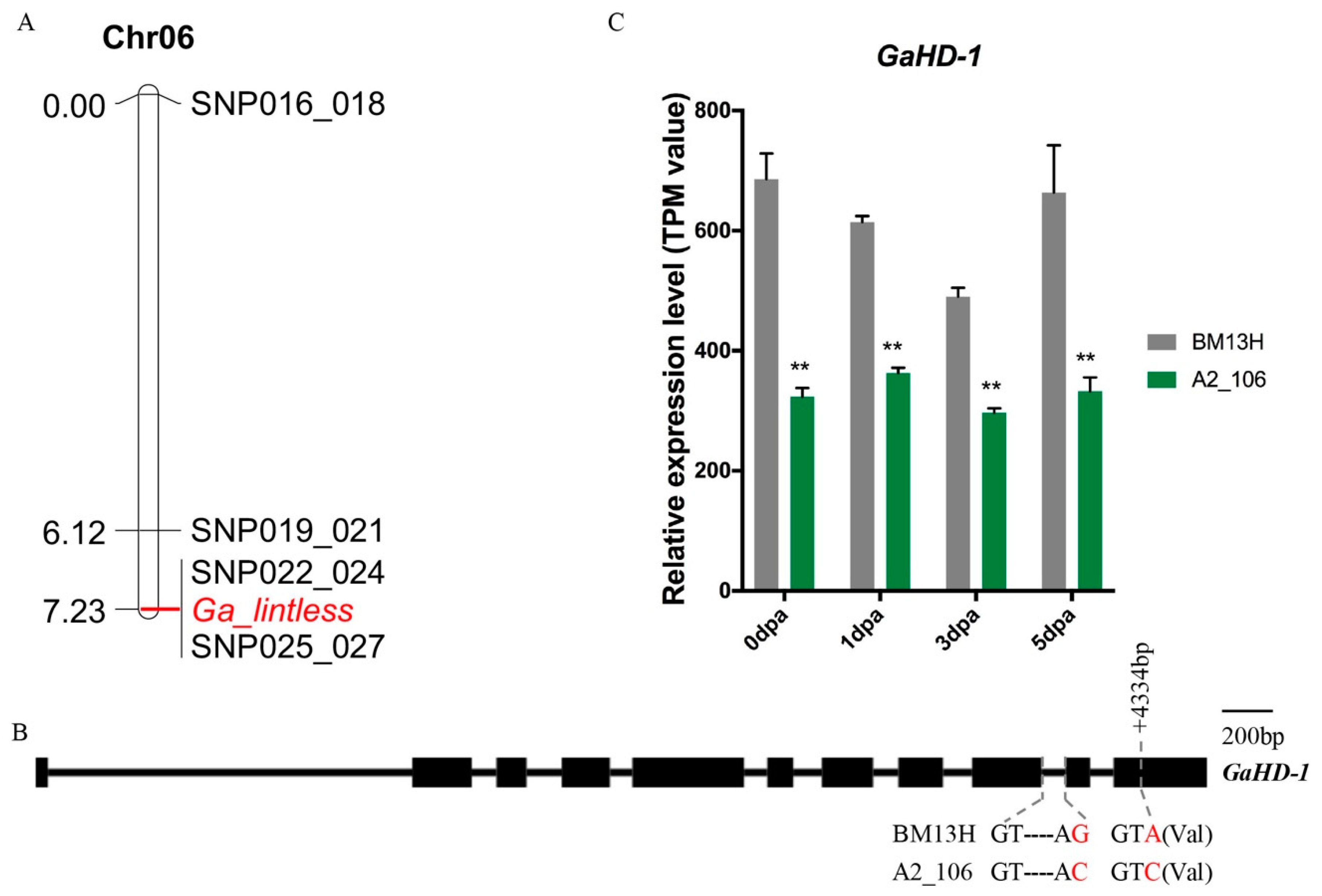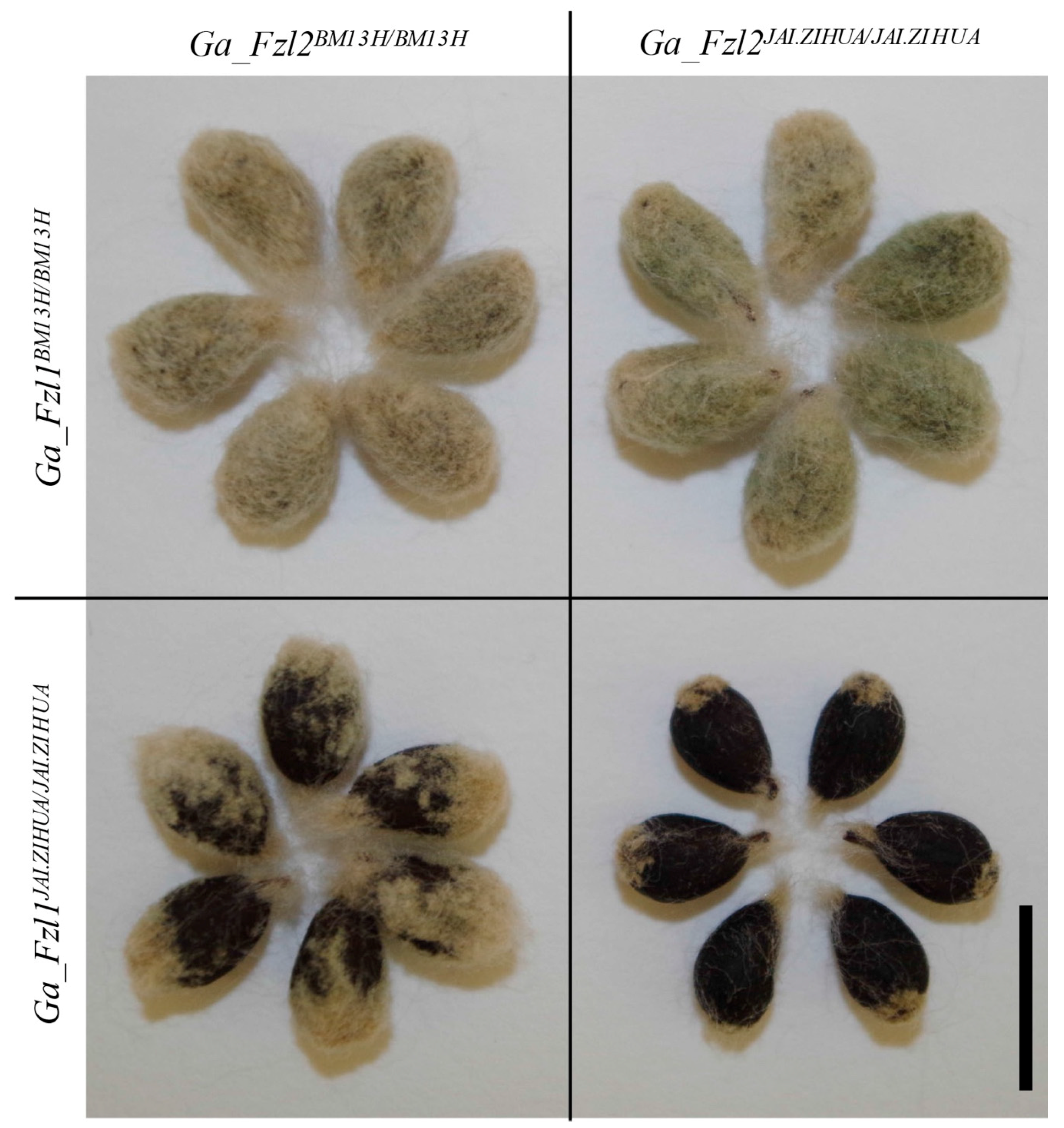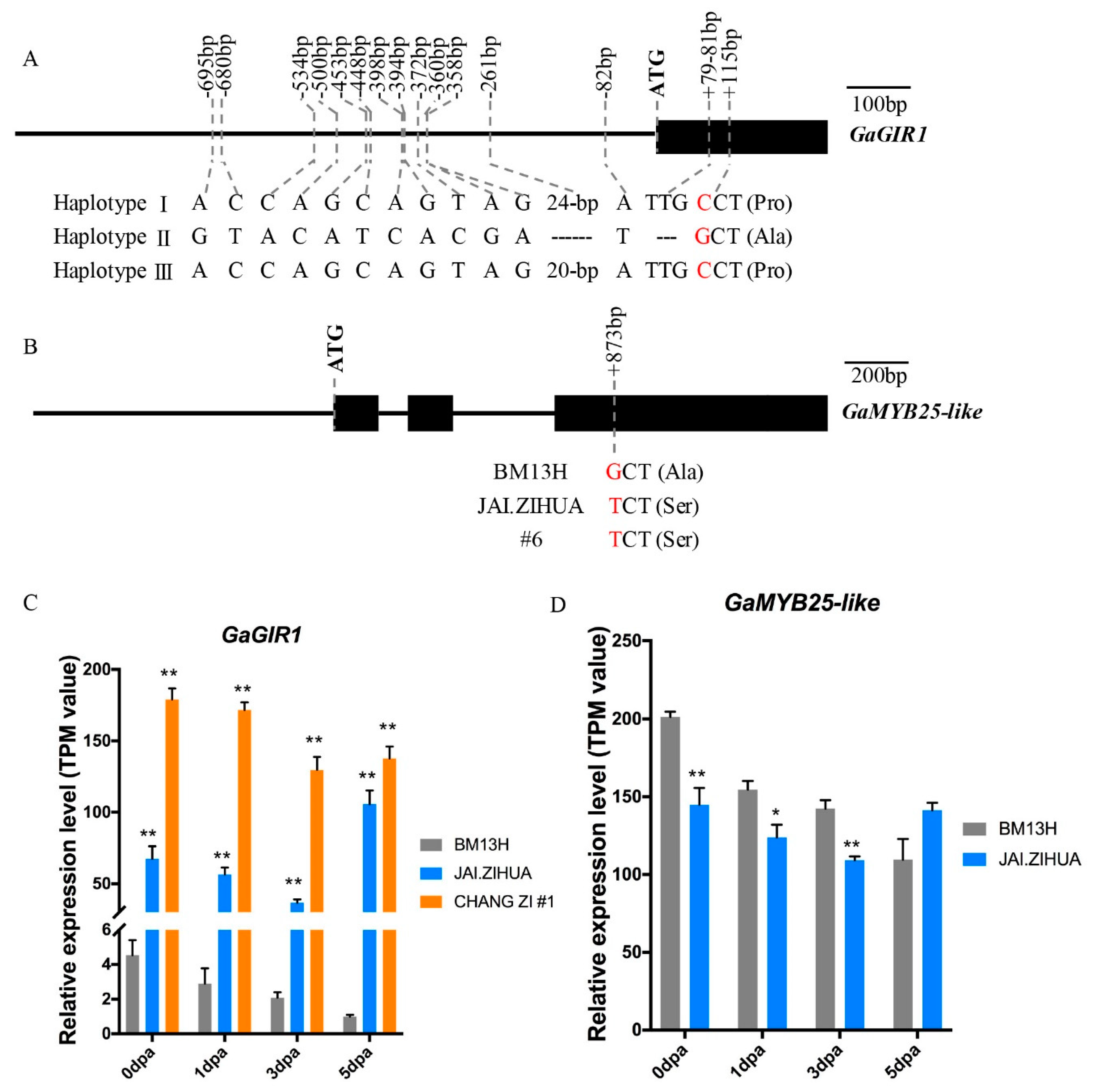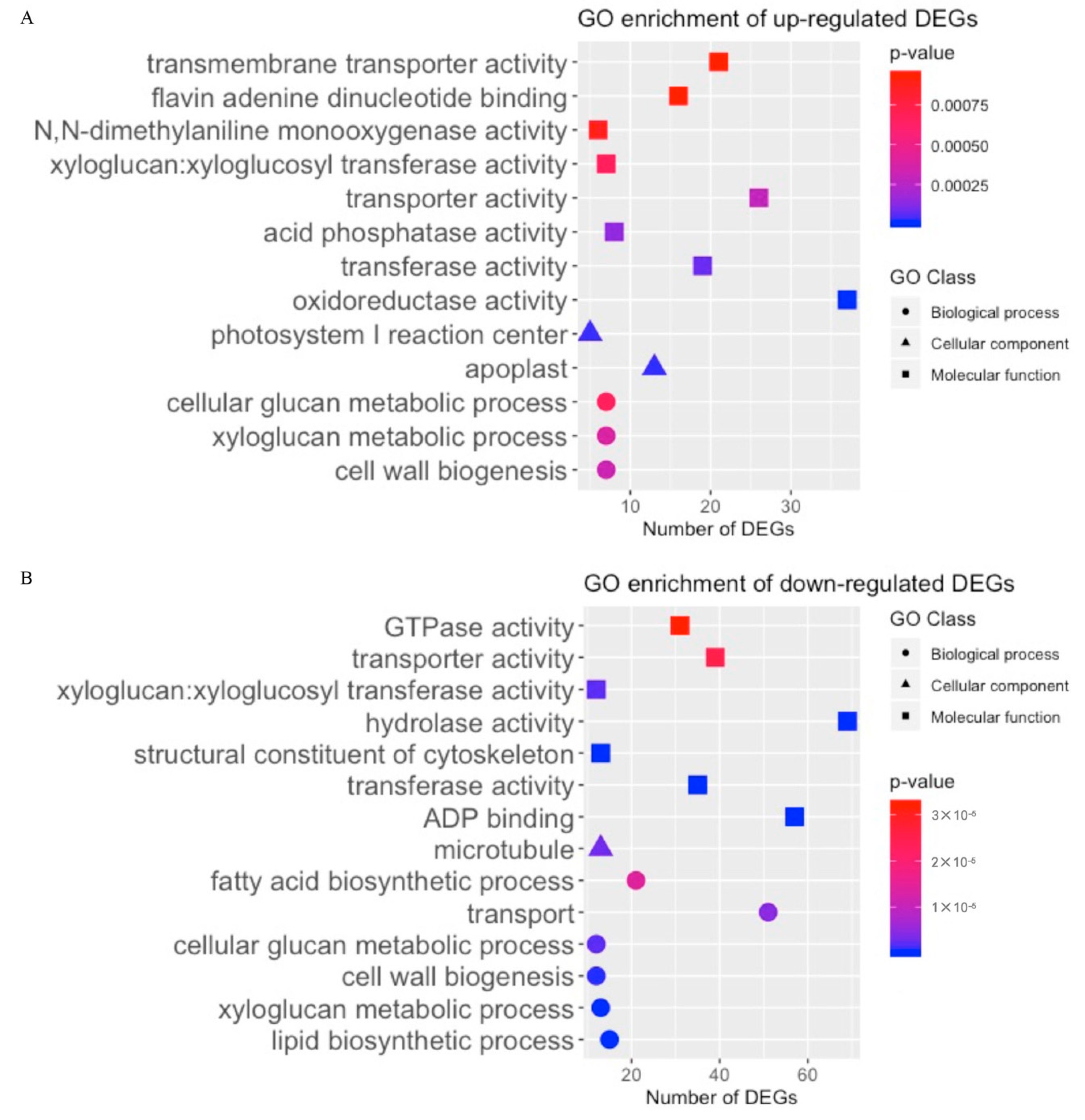Genetic Identification and Transcriptome Analysis of Lintless and Fuzzless Traits in Gossypium arboreum L.
Abstract
1. Introduction
2. Results
2.1. Morphology of the Lintless and Fuzzless Accessions
2.2. Segregation Analysis
2.3. Identification of the Candidate Gene for the Ga_lintless Locus
2.4. Identification of the Candidate Loci Underlying the Fuzzless Trait
2.5. Potential Candidate Genes for the Ga_Fzl1 and Ga_Fzl2 Loci
2.6. Analysis of Transcriptomes Associated with Lint and Fuzz Initiation
2.7. Co-Expression Network Analysis of Genes Associated with Lint Initiation
2.8. Co-Expression Network Analysis of Genes Associated with Fuzz Development
3. Discussion
4. Materials and Methods
4.1. Plant Materials
4.2. DNA Sample Preparation, Sequencing, and SNP Genotyping
4.3. Phenotyping
4.4. Association and Linkage Analyses
4.5. Total RNA Extraction and Transcriptome Sequencing
4.6. RNA-seq Data Analysis
4.7. Gene Ontology and Pathway Analysis
4.8. Construction of Co-Expression Network and Visualisation
5. Conclusions
Supplementary Materials
Author Contributions
Funding
Acknowledgments
Conflicts of Interest
References
- Jabran, K.; Ul-Allah, S.; Chauhan, B.S.; Bakhsh, A. An introduction to global production trends and uses, history and evolution, and genetic and biotechnological improvements in cotton. In Cotton Production, 1st ed.; Jabran, K., Chauhan, B.S., Eds.; Wiley: Hoboken, NJ, USA, 2019; pp. 1–5. [Google Scholar]
- Wendel, J.F. New World tetraploid cottons contain Old World cytoplasm. Proc. Natl. Acad. Sci. USA 1989, 86, 4132–4136. [Google Scholar] [CrossRef] [PubMed]
- Guo, W.Z.; Zhou, B.L.; Yang, L.M.; Wang, W.; Zhang, T.Z. Genetic diversity of landraces in Gossypium arboreum L. race sinense assessed with simple sequence repeat markers. J. Integr. Plant Biol. 2006, 48, 1008–1017. [Google Scholar] [CrossRef]
- Iqbal, M.A.; Abbas, A.; Zafar, Y.; Mehboob-Ur-Rahman. Characterization of indigenous Gossypium arboreum L. genotypes for various fibre quality traits. Pakistan J. Bot. 2015, 47, 2347–2354. [Google Scholar]
- Li, R.; Erpelding, J.E. Genetic diversity analysis of Gossypium arboreum germplasm accessions using genotyping-by-sequencing. Genetica 2016, 144, 535–545. [Google Scholar] [CrossRef]
- Erpelding, J.E. Inheritance of the Ovule Fuzzless Trait for Gossypium arboreum Germplasm Line PI 529708. Int. J. Plant Breeding Genet. 2016, 11, 25–30. [Google Scholar] [CrossRef]
- Tan, J.; Walford, S.A.; Dennis, E.S.; Llewellyn, D. Trichomes control flower bud shape by linking together young petals. Nat. Plants 2016, 2, 16093. [Google Scholar] [CrossRef]
- Xiao, K.; Mao, X.; Lin, Y. Trichome, a Functional Diversity Phenotype in Plant. Mol. Biol. 2017, s1. [Google Scholar] [CrossRef]
- Lukefahr, M.J.; Houghtaling, J.E.; Graham, H.M. Suppression of Heliothis Lepidoptera-Noctuidae Populations with Glabrous Cotton Strains. J. Economic Entomol. 1971, 64, 486–488. [Google Scholar] [CrossRef]
- Lee, J.A. Revision of the Genetics of the Hairiness-Smoothness System of Gossypium. J. Hered. 1985, 76, 123–126. [Google Scholar] [CrossRef]
- Thomson, N.J.; Reid, P.E.; Williams, E.R. Effects of the okra leaf, nectariless, frego bract and glabrous conditions on yield and quality of cotton lines. Euphytica 1987, 36, 545–553. [Google Scholar] [CrossRef]
- Meredith, W.R.; Pettigrew, W.T.; Heitholt, J.J. Sub-okra, semi-smoothness, and nectariless effect on cotton lint yield. Crop Sci. 1996, 36, 22–25. [Google Scholar] [CrossRef]
- Endrizzi, J.E.; Turcotte, E.L.; Kohel, R.J. Qualitative genetics, cytology, and cytogenetics. In Cotton, 1st ed.; Kohel, R.J., Lewis, C.F., Eds.; University of Wisconsin Press: Madison, WI, USA, 1984; pp. 81–129. [Google Scholar]
- Percy, R.G.; Kohel, R.J. Qualitative genetics. In Cotton: Origin, History, Technology, and Production, 1st ed.; Smith, C.W., Cothren, J.T., Eds.; Wiley Press: New York, NY, USA, 1999; pp. 319–360. [Google Scholar]
- Walford, S.A.; Wu, Y.; Llewellyn, D.J.; Dennis, E.S. Epidermal cell differentiation in cotton mediated by the homeodomain leucine zipper gene, GhHD-1. Plant J. 2012, 71, 464–478. [Google Scholar] [CrossRef] [PubMed]
- Liu, D.; Liu, F.; Shan, X.; Zhang, J.; Tang, S.; Fang, X.; Liu, X.; Wang, W.; Tan, Z.; Teng, Z.; et al. Construction of a high-density genetic map and lint percentage and cottonseed nutrient trait QTL identification in upland cotton (Gossypium hirsutum L.). Mol. Genet. Genomics 2015, 290, 1683–1700. [Google Scholar] [CrossRef] [PubMed]
- Ding, M.; Ye, W.; Lin, L.; He, S.; Du, X.; Chen, A.; Cao, Y.; Qin, Y.; Yang, F.; Jiang, Y.; et al. The Hairless Stem Phenotype of Cotton (Gossypium barbadense) Is Linked to a Copia-Like Retrotransposon Insertion in a Homeodomain-Leucine Zipper Gene (HD1). Genetics 2015, 201, 143–154. [Google Scholar] [CrossRef]
- Niu, E.L.; Cai, C.P.; Bao, J.H.; Wu, S.; Zhao, L.; Guo, W.Z. Up-regulation of a homeodomain-leucine zipper gene HD-1 contributes to trichome initiation and development in cotton. J. Integrat. Agric. 2019, 18, 361–371. [Google Scholar] [CrossRef]
- Tang, M.; Wu, X.; Cao, Y.; Qin, Y.; Ding, M.; Jiang, Y.; Sun, C.; Zhang, H.; Paterson, A.H.; Rong, J. Preferential insertion of a Ty1 LTR-retrotransposon into the A sub-genome’s HD1 gene significantly correlated with the reduction in stem trichomes of tetraploid cotton. Mol. Genet. Genomics 2019, 295, 47–54. [Google Scholar] [CrossRef]
- Boykin, J.C. Cultivar differences in gin stand energy utilization. Transactions Asabe 2007, 50, 733–743. [Google Scholar] [CrossRef]
- Bardak, A.; BÖLek, Y. Inheritance of fuzz and lint fiber initiation of cotton (Gossypium hirsutum L.). Turkish J. Agric. Forestry 2016, 40, 606–612. [Google Scholar] [CrossRef]
- Zhu, Q.H.; Yuan, Y.; Stiller, W.; Jia, Y.; Wang, P.; Pan, Z.; Du, X.; Llewellyn, D.; Wilson, I. Genetic dissection of the fuzzless seed trait in Gossypium barbadense. J. Exp. Bot. 2018, 69, 997–1009. [Google Scholar] [CrossRef]
- Stewart, J.M. Fibre initiation on the cotton ovule (Gossypium Hirsutum). Am. J. Bot. 1975, 62, 723–730. [Google Scholar] [CrossRef]
- Ware, J.O.; Benedict, L.I.; Rolfe, W.H. A recessive naked-seed character in upland cotton. J. Hered 1947, 38, 313–320. [Google Scholar] [PubMed]
- Bechere, E.; Boykin, J.J.; Meredith, J.W. Evaluation of cotton genotypes for ginning energy and ginning rate. J. Cotton Sci. 2011, 15, 11–21. [Google Scholar]
- Turley, R.B.; Vaughn, K.C.; Scheffler, J.A. Lint development and properties of fifteen fuzzless seed lines of Upland cotton (Gossypium hirsutum L.). Euphytica 2007, 156, 57–65. [Google Scholar] [CrossRef]
- Padmalatha, K.V.; Patil, D.P.; Kumar, K.; Dhandapani, G.; Kanakachari, M.; Phanindra, M.L.; Kumar, S.; Mohan, T.C.; Jain, N.; Prakash, A.H.; et al. Functional genomics of fuzzless-lintless mutant of Gossypium hirsutum L. cv. MCU5 reveal key genes and pathways involved in cotton fibre initiation and elongation. BMC Genomics 2012, 13, 624. [Google Scholar] [CrossRef] [PubMed]
- Bellaloui, N.; Stetina, S.R.; Turley, R.B. Cottonseed protein, oil, and mineral status in near-isogenic Gossypium hirsutum cotton lines expressing fuzzy/linted and fuzzless/linted seed phenotypes under field conditions. Front. Plant Sci. 2015, 6, 137. [Google Scholar] [CrossRef] [PubMed]
- Zhang, D.; Zhang, T.; Sang, Z.; Guo, W. Comparative development of lint and fuzz using different cotton fiber-specific developmental mutants in Gossypium hirsutum. J. Integr. Plant Biol. 2007, 49, 1038–1046. [Google Scholar] [CrossRef]
- Bechere, E.; Turley, R.B.; Auld, D.L.; Zeng, L. A new fuzzless seed locus in an upland cotton (Gossypium hirsutum) Mutant. Am. J. Plant Sci. 2012, 3, 799–804. [Google Scholar] [CrossRef]
- Fang, D.D.; Naoumkina, M.; Kim, H.J. Unraveling cotton fiber development using fiber mutants in the post-genomic Era. Crop Sci. 2018, 58, 2214. [Google Scholar] [CrossRef]
- Rong, J.; Pierce, G.J.; Waghmare, V.N.; Rogers, C.J.; Desai, A.; Chee, P.W.; May, O.L.; Gannaway, J.R.; Wendel, J.F.; Wilkins, T.A.; et al. Genetic mapping and comparative analysis of seven mutants related to seed fiber development in cotton. Theor. Appl. Genet. 2005, 111, 1137–1146. [Google Scholar] [CrossRef]
- Wan, Q.; Guan, X.; Yang, N.; Wu, H.; Pan, M.; Liu, B.; Fang, L.; Yang, S.; Hu, Y.; Ye, W.; et al. Small interfering RNAs from bidirectional transcripts of GhMML3_A12 regulate cotton fiber development. New Phytol. 2016, 210, 1298–1310. [Google Scholar] [CrossRef]
- Endrizzi, J.E.; Ramsay, G. Identification of ten chromosome deficiencies of cotton. J. Hered. 1980, 71, 45–48. [Google Scholar] [CrossRef]
- Wu, H.; Tian, Y.; Wan, Q.; Fang, L.; Guan, X.; Chen, J.; Hu, Y.; Ye, W.; Zhang, H.; Guo, W.; et al. Genetics and evolution of MIXTA genes regulating cotton lint fiber development. New Phytol. 2018, 217, 883–895. [Google Scholar] [CrossRef] [PubMed]
- Hutchinson, J.B. The genetics of cotton Part XV The inheritance of fuzz and lintlessness and associated characters in Asiatic cottons. J. Genet. 1935, 31, 451–470. [Google Scholar] [CrossRef]
- Desai, A.; Chee, P.W.; May, O.L.; Paterson, A.H. Correspondence of trichome mutations in diploid and tetraploid cottons. J. Hered. 2008, 99, 182–186. [Google Scholar] [CrossRef]
- Du, X.; Huang, G.; He, S.; Yang, Z.; Sun, G.; Ma, X.; Li, N.; Zhang, X.; Sun, J.; Liu, M.; et al. Resequencing of 243 diploid cotton accessions based on an updated A genome identifies the genetic basis of key agronomic traits. Nat. Genet. 2018, 50, 796–802. [Google Scholar] [CrossRef]
- Feng, X.; Cheng, H.; Zuo, D.; Zhang, Y.; Wang, Q.; Liu, K.; Ashraf, J.; Yang, Q.; Li, S.; Chen, X.; et al. Fine mapping and identification of the fuzzless gene GaFzl in DPL972 (Gossypium arboreum). Theor. Appl. Genet. 2019, 132, 2169–2179. [Google Scholar] [CrossRef]
- Hutchinson, J.B.; Gadkari, P.D. The genetics of lintlessness in Asiatic cottons. J. Genet. 1937, 35, 161. [Google Scholar] [CrossRef]
- Erpelding, J.E.; Turley, R.B. Genetics of ovule fibreless and foliar glabrous traits in the Gossypium arboretum germplasm line in PI 529740. Asian J. Plant Sci. 2013, 3, 5–8. [Google Scholar]
- Wu, R.; Citovsky, V. Adaptor proteins GIR1 and GIR2. I. Interaction with the repressor GLABRA2 and regulation of root hair development. Biochem. Biophys. Res. Commun. 2017, 488, 547–553. [Google Scholar] [CrossRef]
- Wang, S.; Wang, J.W.; Yu, N.; Li, C.H.; Luo, B.; Gou, J.Y.; Wang, L.J.; Chen, X.Y. Control of plant trichome development by a cotton fiber MYB gene. Plant Cell 2004, 16, 2323–2334. [Google Scholar] [CrossRef]
- Machado, A.; Wu, Y.; Yang, Y.; Llewellyn, D.J.; Dennis, E.S. The MYB transcription factor GhMYB25 regulates early fibre and trichome development. Plant J. 2009, 59, 52–62. [Google Scholar] [CrossRef] [PubMed]
- Walford, S.A.; Wu, Y.; Llewellyn, D.J.; Dennis, E.S. GhMYB25-like: A key factor in early cotton fibre development. Plant J. 2011, 65, 785–797. [Google Scholar] [CrossRef] [PubMed]
- Zhang, M.; Zheng, X.; Song, S.; Zeng, Q.; Hou, L.; Li, D.; Zhao, J.; Wei, Y.; Li, X.; Luo, M.; et al. Spatiotemporal manipulation of auxin biosynthesis in cotton ovule epidermal cells enhances fiber yield and quality. Nat. Biotechnol. 2011, 29, 453–458. [Google Scholar] [CrossRef] [PubMed]
- Hu, H.; He, X.; Tu, L.; Zhu, L.; Zhu, S.; Ge, Z.; Zhang, X. GhJAZ2 negatively regulates cotton fiber initiation by interacting with the R2R3-MYB transcription factor GhMYB25-like. Plant J. 2016, 88, 921–935. [Google Scholar] [CrossRef]
- Wu, Y.; Machado, A.C.; White, R.G.; Llewellyn, D.J.; Dennis, E.S. Expression profiling identifies genes expressed early during lint fibre initiation in cotton. Plant Cell Physiol. 2006, 47, 107–127. [Google Scholar] [CrossRef]
- Hande, A.S.; Katageri, I.S.; Jadhav, M.P.; Adiger, S.; Gamanagatti, S.; Padmalatha, K.V.; Dhandapani, G.; Kanakachari, M.; Kumar, P.A.; Reddy, V.S. Transcript profiling of genes expressed during fibre development in diploid cotton (Gossypium arboreum L.). BMC Genomics 2017, 18, 675. [Google Scholar] [CrossRef]
- Qin, Y.; Sun, H.; Hao, P.; Wang, H.; Wang, C.; Ma, L.; Wei, H.; Yu, S. Transcriptome analysis reveals differences in the mechanisms of fiber initiation and elongation between long- and short-fiber cotton (Gossypium hirsutum L.) lines. BMC Genomics 2019, 20, 633. [Google Scholar] [CrossRef]
- Miyazaki, J.; Stiller, W.N.; Wilson, L.J. Novel cotton germplasm with host plant resistance to twospotted spider mite. Field Crops Research 2012, 134, 114–121. [Google Scholar] [CrossRef]
- Ellis, M.H.; Rebetzke, G.J.; Azanza, F.; Richards, R.A.; Spielmeyer, W. Molecular mapping of gibberellin-responsive dwarfing genes in bread wheat. Theor. Appl. Genet. 2005, 111, 423–430. [Google Scholar] [CrossRef]
- Andrews, S. FastQC: A Quality Control Tool for High Throughput Sequence Data; Babraham Bioinformatics: Babraham, UK, 2011. [Google Scholar]
- Li, H.; Durbin, R. Fast and accurate short read alignment with Burrows-Wheeler transform. Bioinformatics 2009, 25, 1754–1760. [Google Scholar] [CrossRef]
- Li, H.; Handsaker, B.; Wysoker, A.; Fennell, T.; Ruan, J.; Homer, N.; Marth, G.; Abecasis, G.; Durbin, R.; Genome Project Data Processing Subgroup. The Sequence Alignment/Map format and SAMtools. Bioinformatics 2009, 25, 2078–2079. [Google Scholar] [CrossRef] [PubMed]
- Li, H. A statistical framework for SNP calling, mutation discovery, association mapping and population genetical parameter estimation from sequencing data. Bioinformatics 2011, 27, 2987–2993. [Google Scholar] [CrossRef] [PubMed]
- Thorvaldsdottir, H.; Robinson, J.T.; Mesirov, J.P. Integrative Genomics Viewer (IGV): High-performance genomics data visualization and exploration. Brief Bioinform. 2013, 14, 178–192. [Google Scholar] [CrossRef] [PubMed]
- Zhu, Q.H.; Zhang, J.; Liu, D.; Stiller, W.; Liu, D.; Zhang, Z.; Llewellyn, D.; Wilson, I. Integrated mapping and characterization of the gene underlying the okra leaf trait in Gossypium hirsutum L. J. Exp. Bot. 2016, 67, 763–774. [Google Scholar] [CrossRef]
- Talbot, M.J.; White, R.G. Methanol fixation of plant tissue for Scanning Electron Microscopy improves preservation of tissue morphology and dimensions. Plant Methods 2013, 9, 36. [Google Scholar] [CrossRef]
- Ooijn, V. JoinMap 4.0, Software for the Calculation of Genetic Linkage Maps in Experimental Populations; Kyazma B.V.: Wageningen, Netherlands, 2006. [Google Scholar]
- Bolger, A.M.; Lohse, M.; Usadel, B. Trimmomatic: A flexible trimmer for Illumina sequence data. Bioinformatics 2014, 30, 2114–2120. [Google Scholar] [CrossRef]
- Stephen, S.; Cullerne, D.; Spriggs, A.; Helliwell, C.; Lovell, D.; Taylor, J. Biokanga: A Suite of High Performance Bioinformatics Applications. Available online: https://github.com/csiro-crop-informatics/biokanga (accessed on 5 October 2019).
- Anders, S.; Pyl, P.T.; Huber, W. HTSeq--a Python framework to work with high-throughput sequencing data. Bioinformatics 2015, 31, 166–169. [Google Scholar] [CrossRef]
- Love, M.I.; Huber, W.; Anders, S. Moderated estimation of fold change and dispersion for RNA-seq data with DESeq2. Genome Biol 2014, 15, 550. [Google Scholar] [CrossRef]
- Yu, G.; Wang, L.G.; Han, Y.; He, Q.Y. clusterProfiler: An R package for comparing biological themes among gene clusters. OMICS 2012, 16, 284–287. [Google Scholar] [CrossRef]
- Langfelder, P.; Horvath, S. WGCNA: An R package for weighted correlation network analysis. BMC Bioinformatics 2008, 9, 559. [Google Scholar] [CrossRef]









| Cross ID | Parents | Phenotype | Phenotype | |||||
|---|---|---|---|---|---|---|---|---|
| Female | Male | Fuzzless | Fuzzy | χ2 | Normal | Lintless | χ2 | |
| A | BM13H | #47 | 28 | 43 | 47.89 | |||
| B | BM13H | NANTONG | 49 | 28 | 5.30 | |||
| C | BM13H | #6 | 44 | 32 | 11.86 | |||
| D | BM13H | CHANG ZI #1 | 63 | 27 | 1.20 | |||
| E | BM13H | NAN.GINGJING | 59 | 31 | 4.28 | |||
| F | BM13H | BANI | 57 | 25 | 1.32 | |||
| G | BM13H | JAI.ZIHUA | 51 | 42 | 20.16 | |||
| H | BM13H | A2_106 | 67 | 23 | 0.01 | |||
| Cross ID | Marker | Chromosome | Physical Position | p-Value |
|---|---|---|---|---|
| A | SNP004_006 | Chr08 | 905,375 | < 0.0001 |
| B | SNP004_006 | Chr08 | 905,375 | < 0.0001 |
| C | SNP004_006 | Chr08 | 905,375 | < 0.0001 |
| C | SNP001_003 | Chr12 | 14,892,043 | 0.0186 |
| D | SNP010_012 | Chr08 | 906,144 | < 0.0001 |
| E | SNP004_006 | Chr08 | 905,375 | < 0.0001 |
| F | SNP010_012 | Chr08 | 906,144 | < 0.0001 |
| G | SNP004_006 | Chr08 | 905,375 | < 0.0001 |
| G | SNP001_003 | Chr12 | 14,892,043 | < 0.0001 |
© 2020 by the authors. Licensee MDPI, Basel, Switzerland. This article is an open access article distributed under the terms and conditions of the Creative Commons Attribution (CC BY) license (http://creativecommons.org/licenses/by/4.0/).
Share and Cite
Liu, X.; Moncuquet, P.; Zhu, Q.-H.; Stiller, W.; Zhang, Z.; Wilson, I. Genetic Identification and Transcriptome Analysis of Lintless and Fuzzless Traits in Gossypium arboreum L. Int. J. Mol. Sci. 2020, 21, 1675. https://doi.org/10.3390/ijms21051675
Liu X, Moncuquet P, Zhu Q-H, Stiller W, Zhang Z, Wilson I. Genetic Identification and Transcriptome Analysis of Lintless and Fuzzless Traits in Gossypium arboreum L. International Journal of Molecular Sciences. 2020; 21(5):1675. https://doi.org/10.3390/ijms21051675
Chicago/Turabian StyleLiu, Xueying, Philippe Moncuquet, Qian-Hao Zhu, Warwick Stiller, Zhengsheng Zhang, and Iain Wilson. 2020. "Genetic Identification and Transcriptome Analysis of Lintless and Fuzzless Traits in Gossypium arboreum L." International Journal of Molecular Sciences 21, no. 5: 1675. https://doi.org/10.3390/ijms21051675
APA StyleLiu, X., Moncuquet, P., Zhu, Q.-H., Stiller, W., Zhang, Z., & Wilson, I. (2020). Genetic Identification and Transcriptome Analysis of Lintless and Fuzzless Traits in Gossypium arboreum L. International Journal of Molecular Sciences, 21(5), 1675. https://doi.org/10.3390/ijms21051675







